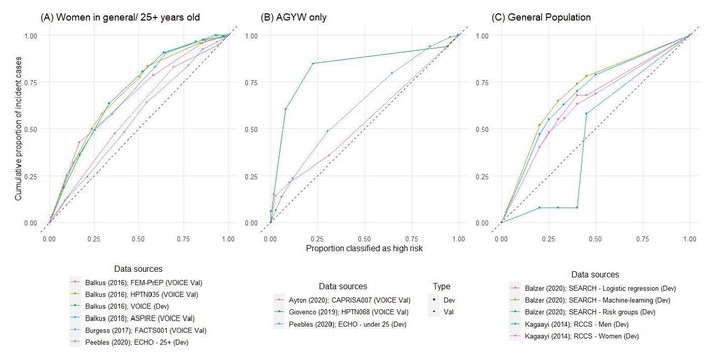Risk scores for predicting HIV incidence among the general population in sub-Saharan Africa: a systematic review and meta-analysis
 Unpublished figure
Unpublished figure
Abstract
Risk scoring tool helps prioritise prevention strategies for people most-at-risk of acquiring HIV. Several HIV risk scores have been developed for the sub-Saharan contexts and their accuracy and efficiency need to be summarised. We systematically searched nine databases for studies that developed and/or validated HIV risk scores among the general population in sub-Saharan Africa. We used random-effect meta-analysis to summarise adjusted and crude hazard ratios for prognostic factors, and the area under the receiver-operating characteristic curve (AUC-ROC) to quantify predictive performance. From 1563 initial search records, we identified 14 risk scores from 13 studies. Consistently identified prognostic factors among women were age under 25 (pooled adjusted hazard ratio: 1.62 [95% Confidence Interval: 1.17, 2.23]), single/not cohabiting with primary partners (2.33 [1.73, 3.13]) and having sexually transmitted infections (STIs) (HSV-2: 1.67 [1.34, 2.09]; curable STIs: 1.45 [1.17; 1.79]). Among AGYW only STIs were consistently identified, but studies were limited (n=3). The AUC-ROC ranged from 0.56 to 0.79 on the model development sets. Only the VOICE score was externally validated by multiple studies, with pooled AUC-ROC 0.612 [0.570, 0.654] (I2: 70.10%). In conclusion, younger age, non-cohabiting, and recent STIs were consistently identified as predicting future HIV infection. Given the heterogeneous context and baseline prevalence, HIV risk scores had only low to moderate discriminatory ability to predict future infection and uncertain generalisability outside of study populations. Further evidence on the importance of specific factors and data outside high-risk study populations will help inform optimal implementation in HIV programmes.